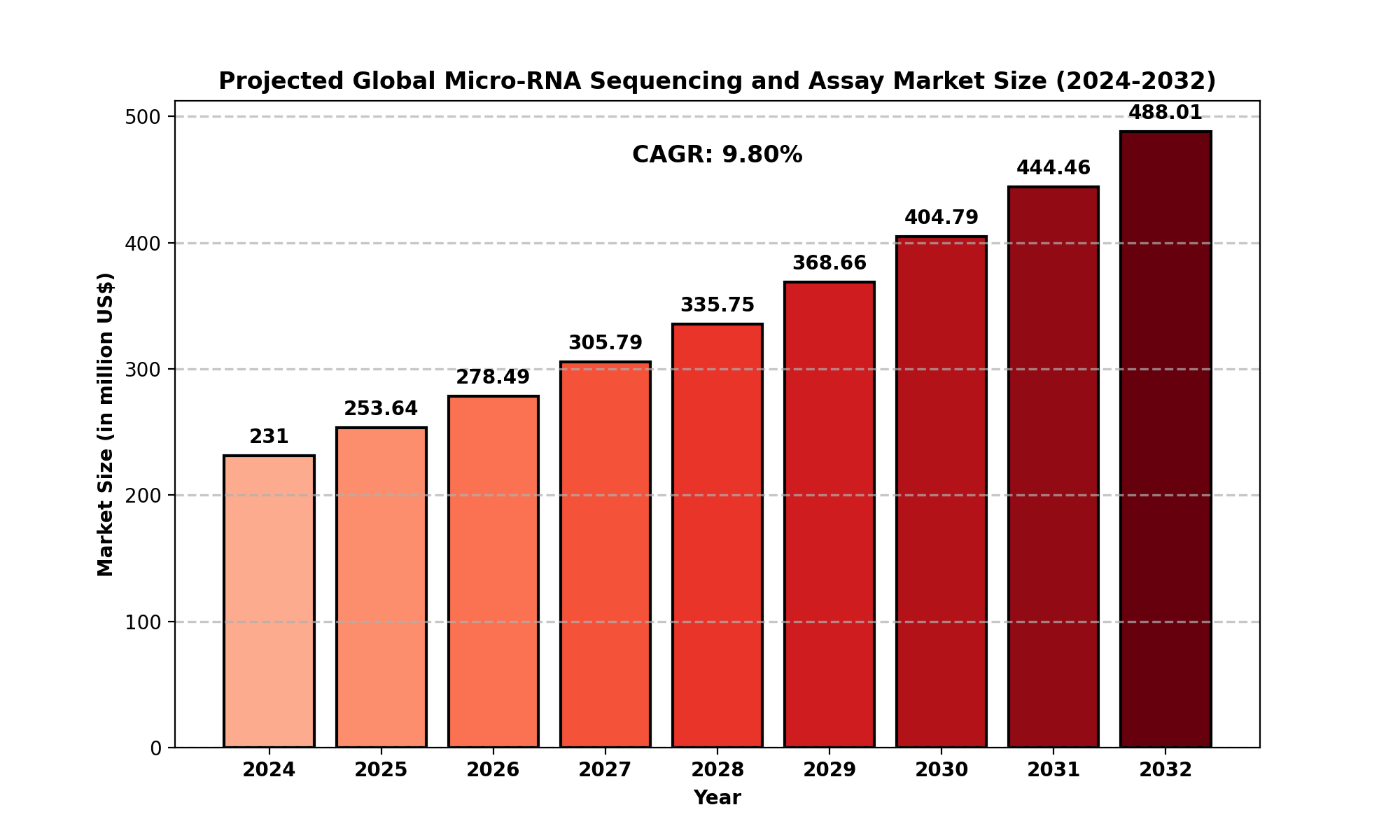TOP CATEGORY: Chemicals & Materials | Life Sciences | Banking & Finance | ICT Media

Download Report PDF Instantly
Report overview
MicroRNA sequencing (miRNA-seq) is a specialized form of RNA sequencing (RNA-seq) that employs next-generation sequencing (NGS) technology to analyze microRNAs (miRNAs). These short, non-coding RNA molecules play crucial roles in gene regulation. Unlike conventional RNA-seq, miRNA-seq is optimized to enrich small RNA fragments, enabling researchers to study miRNA expression patterns, discover novel miRNAs, and analyze disease-related miRNA dysregulation. Given its significance in disease diagnostics, particularly in oncology, miRNA-seq is increasingly becoming an essential tool in molecular research and clinical applications.
Market Size
The global Micro-RNA Sequencing and Assay market is valued at approximately USD 231 million in 2024 . With a projected Compound Annual Growth Rate (CAGR) of 9.80%, the market is expected to reach USD 488.01 million by 2032.
The North American market, estimated at USD 70.73 million in 2024, is set to grow at a CAGR of 8.40% during the same period.
This steady expansion is attributed to the rising adoption of NGS technologies, increased funding for genomic research, and growing interest in miRNA’s role in personalized medicine and disease prognosis.

Market Dynamics (Drivers, Restraints, Opportunities, and Challenges)
Drivers
Advancements in Next-Generation Sequencing: Continuous improvements in sequencing technology have reduced costs and improved efficiency, fueling the adoption of miRNA-seq.
Growing Prevalence of Cancer and Chronic Diseases: With miRNAs playing a critical role in cancer diagnostics and treatment, demand for miRNA-seq is increasing.
Government Funding and Research Initiatives: Investments in genomics and precision medicine are accelerating market growth.
Rising Demand for Personalized Medicine: The shift toward tailored treatments based on genetic profiling is boosting miRNA sequencing applications.
Restraints
High Costs and Infrastructure Requirements: Despite declining costs, sequencing remains expensive, limiting adoption in smaller research institutions.
Data Complexity and Standardization Issues: Analyzing and interpreting miRNA-seq data requires sophisticated bioinformatics tools, posing a challenge for many users.
Opportunities
Integration with Artificial Intelligence (AI) and Machine Learning: AI-driven bioinformatics can enhance miRNA-seq analysis and expand its clinical utility.
Emerging Markets in Asia-Pacific: Rapid advancements in healthcare infrastructure and genomics research in countries like China and India present growth potential.
Expanding Applications in Neurological Disorders: Research into miRNA’s role in neurodegenerative diseases is opening new avenues for miRNA sequencing.
Challenges
Regulatory and Ethical Concerns: Compliance with stringent regulatory frameworks remains a barrier to widespread adoption.
Limited Awareness in Emerging Markets: Lack of expertise and awareness about miRNA-seq in developing regions can hinder market growth.
Regional Analysis
North America
Dominates the market due to advanced healthcare infrastructure, strong funding, and high adoption of NGS technologies.
The U.S. leads in miRNA-seq research, driven by major biotech companies and academic institutions.
Europe
Increasing government support for genomic research and precision medicine is driving growth.
Countries like Germany and the UK are key contributors due to strong healthcare policies and research funding.
Asia-Pacific
Fastest-growing region, fueled by technological advancements, increasing healthcare expenditure, and rising genomic research initiatives in China, Japan, and India.
South America & MEA
Gradual growth due to improving healthcare systems and rising interest in genomics research.
Countries like Brazil and South Africa are emerging as potential markets.
Competitor Analysis
The market is dominated by major biotechnology and life sciences companies, each offering advanced sequencing technologies:
Illumina: Leading provider of NGS platforms with strong market presence.
Thermo Fisher Scientific: Offers a comprehensive portfolio of sequencing and assay solutions.
QIAGEN: Specializes in miRNA research tools and sequencing solutions.
Takara Bio: Provides innovative sequencing technologies for small RNA analysis.
NEB (New England Biolabs): Focuses on high-quality reagents and sequencing kits.
Market Segmentation (by Type)
Sequencing by Synthesis (SBS): Most widely used technology, known for its high accuracy.
Sequencing by Nanopore: Emerging method offering long-read sequencing capabilities.
Ion Semiconductor Sequencing: Cost-effective alternative, suitable for targeted miRNA analysis.
Market Segmentation (by Application)
Research Institutes: Largest end-user segment, driving demand for advanced sequencing technologies.
Academia: Increasing use in university research programs and genomic studies.
Contract Research Organizations (CROs): Growing role in outsourced sequencing services and drug discovery.
Geographic Segmentation
North America (USA, Canada, Mexico)
Europe (Germany, UK, France, Russia, Italy, Rest of Europe)
Asia-Pacific (China, Japan, South Korea, India, Southeast Asia, Rest of Asia-Pacific)
South America (Brazil, Argentina, Columbia, Rest of South America)
Middle East and Africa (MEA) (Saudi Arabia, UAE, Egypt, Nigeria, South Africa, Rest of MEA)
FAQ Section
What is the current market size of the Micro-RNA Sequencing and Assay market?
Which are the key companies operating in this market?
What are the key growth drivers in this market?
Which regions dominate the Micro-RNA Sequencing and Assay market?
What are the emerging trends in this market?
Key Benefits of This Market Research:
Key Reasons to Buy this Report: